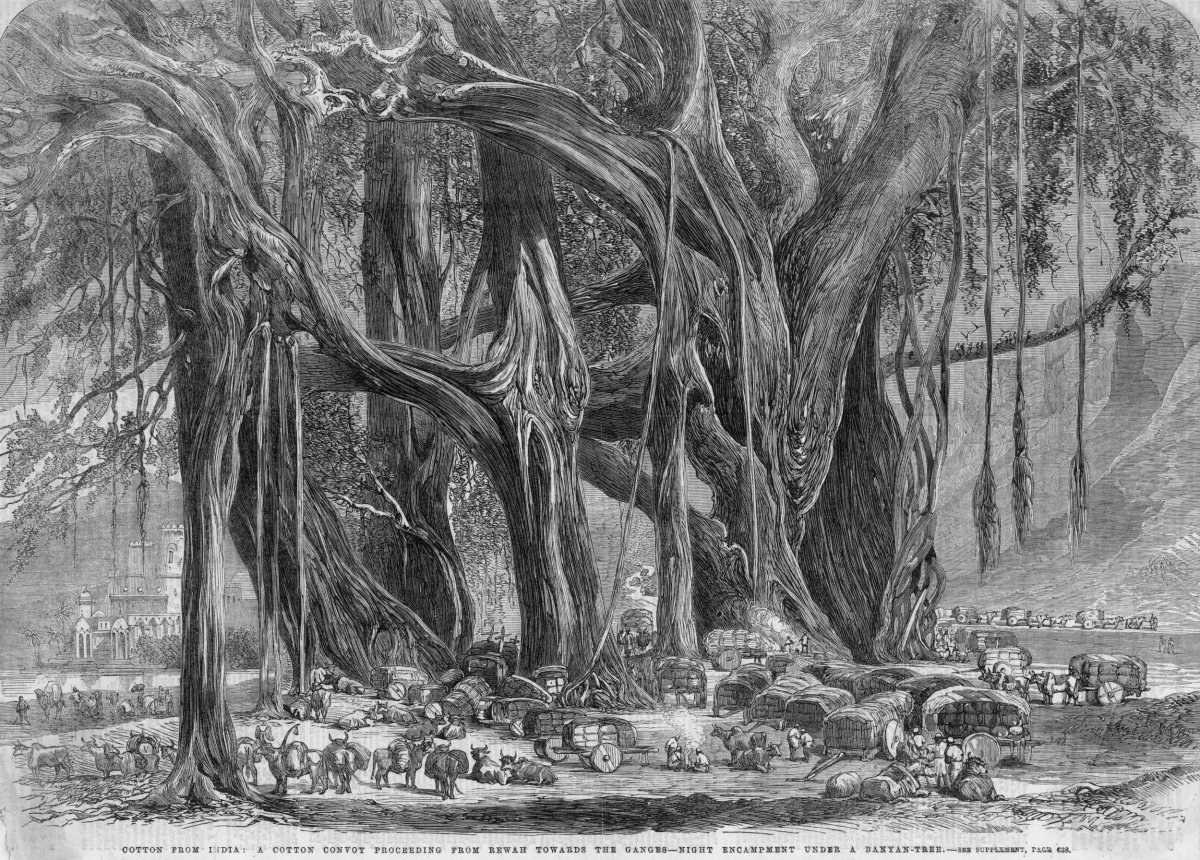
Some 550 years ago, so a story goes, the poet-sage Kabir was on a silt island in India's Narmada River. He was brushing his teeth with a twig. When he flung his toothbrush to the ground, up sprang a gigantic tree whose crown spread so wide it cast shade over a whole hectare of land. Today, Kabir's tree is one of the biggest plants on the planet. Its true story is no less extraordinary than the myth.
It is a banyan (Ficus benghalensis), one of hundreds of species of fig trees. No other plants feature in so rich a mix of folklore and faith stories as the figs. And none is as awesome to behold as the banyan. Walk beneath Kabir's tree's crown and you will see the illusion of a forest, a tight mass of thousands of trees. But look closer and you will see that everything is connected. There is just one tree. The banyan's Sanskrit names —nyagrodha, 'the down-grower' and bahupada, 'the one with many feet'— hint at its secrets.
Many years earlier, another tree had occupied the spot where Kabir's banyan grows. That tree's fate shifted when a bird, or perhaps a bat or monkey, passed by having fed earlier on ripe Ficus benghalensis figs. The animal pooped on the tree and condemned it to a slow death by smothering.
The animal's droppings delivered a banyan seed to a moist nook. Within weeks, the fig seed split open. It sent up a firm stalk with a collar of two tiny green leaves. It sent down tiny roots that hugged the host tree as they stretched earthwards in search of soil. In time, these roots would expand and enlace. They would encase the host tree and erase all trace of it.
As the banyan grew, its branches also sent out roots. They dangled like strands of unkempt hair. When they reached the ground, these roots grew thick and woody and merged to form what looked like new tree trunks. The massive branches reached ever outwards, sending down yet more and more prop roots. These pillars formed increasingly wide circles around the banyan's core, enclosing it in nested cloisters.
When British historian Thomas Maurice wrote about Kabir's banyan in 1794, he said it had more than 350 of these false trunks, each one thicker than an English oak tree, and another 3000 smaller stems. He noted that locals said the tree was 3000 years old, suggesting it existed long before Kabir himself. This raises the possibility that it was the same banyan Alexander the Great and his army encountered on the Narmada River when they arrived in India in 326 BCE.
Alexander's men were certainly the first Europeans known to have seen a banyan. They were amazed. The vivid descriptions they wrote down would inform Theophrastus, the father of modern botany, back home in Greece. But local people saw banyans as much more than impressive trees. The banyans had long been part of the cultural fabric. More than a thousand years earlier, the people of the Indus Valley Civilization adopted a stylized banyan as a symbol in their script. Later Vedic, Jain and Buddhist and Hindu scriptures and stories mention banyans often.
To bodies, these trees provided shelter, food and medicines to treat dozens of disorders. To minds, they formed bridges to the supernatural. Gods and spirits moved among their leaves and pillar roots. By 500 BCE, Hindu texts described a cosmic 'world tree', a banyan that grew upside down with its roots in the heavens. Its trunk and branches reached to Earth to bring blessings to humankind.

The banyan became a potent symbol of fertility, life and resurrection. It features in Hindu stories of the universe's periodic death and rebirth, when everything that exists dissolves into a ceaseless sea. One story says an 'undying' banyan is the only thing to survive the deluge. Another says that to ride the sea's currents, the god Vishnu assumes the form of a baby, lying on his back on a raft formed of a banyan leaf. With one breath, the baby swallows all that surrounds it, taking the turbulent universe into the safety of his stomach before exhaling it into fresh existence.
After the British arrived in India, these symbols of life became agents of death; the British began to use banyans as gallows to execute rebels who resisted their rule. By the 1850s, there had been multiple occasions when they hanged over a hundred men to death from a single banyan. India restored dignity to these trees when it gained independence and made the banyan its national tree.
While the British knew these trees by name, Alexander's army would not have heard the word banyan. The name only arose more than a thousand years later when Portuguese visitors to India modified the Gujarati word vaniyan, meaning merchant. They named the tree banyan after the traders who set up their stalls in its shade.
A banyan is a natural meeting place, a vast umbrella of dark green leathery leaves that blocks out the sun or showers of rain. These trees form the centerpiece of many villages. Entire cities have even grown up around these trees. The city of Vadodara in Gujarat, western India is one example. It is thought to derive its name from the Sanskrit word vatodar, meaning 'in the heart of the banyan tree'. Asia's oldest stock exchange, the Bombay Stock Exchange, was also born beneath a banyan in Mumbai where stockbrokers would gather in the 1850s.
In cities today, the banyans are curtailed by construction or cut down to make way for roads. But if left in peace, there is little to stop a banyan expanding. The biggest one on record exceeds even Kabir's tree. It is said to have begun life in 1434 at the spot where a woman called Thimmamma died when she threw herself onto her husband's funeral pyre. The tree, in Andhra Pradesh, now covers two hectares. Twenty thousand people can shelter beneath its crown.
All this from a seed that is just a couple of millimeters in length. Crack one open with your thumbnail and you won't find much inside, yet the genetic material within has the power to create a tree vast enough to resemble a small forest. Ancient Hindu sages employed this paradox in a parable, which used the imperceptible power within a banyan seed as a parallel of Atman, the invisible essence Hindus say permeates and sustains the universe and all it contains.
The banyan's power reaches deep into our world. Like all fig species, these trees depend on specific wasps to enter their figs and pollinate the flowers hidden within. A side effect of this relationship is that banyan figs are available all year round. They offer a lifeline to birds, fruit bats, monkeys and other creatures, which in turn disperse the seeds of hundreds of tree species, planting the forests of the future. The banyans truly are trees of life.
This is an edited extract of Mike Shanahan's new book Ladders to Heaven: How fig trees shaped our history, fed our imaginations and can enrich our future, published by Unbound on September 8, 2016. It will be published in North America by Chelsea Green Publishing as Gods, Wasps and Stranglers in November.
Uncommon Knowledge
Newsweek is committed to challenging conventional wisdom and finding connections in the search for common ground.
Newsweek is committed to challenging conventional wisdom and finding connections in the search for common ground.
About the writer
To read how Newsweek uses AI as a newsroom tool, Click here.








